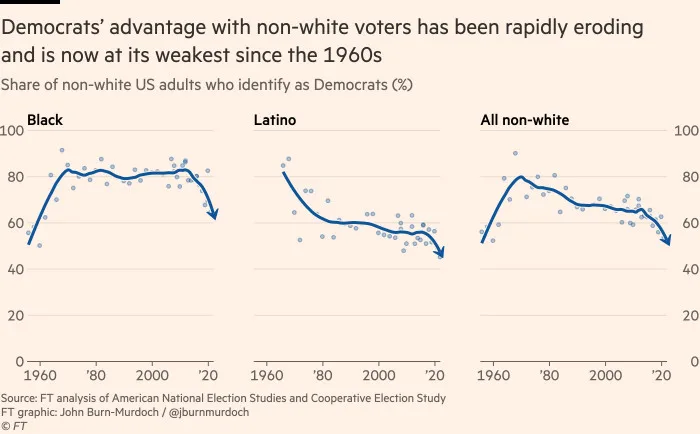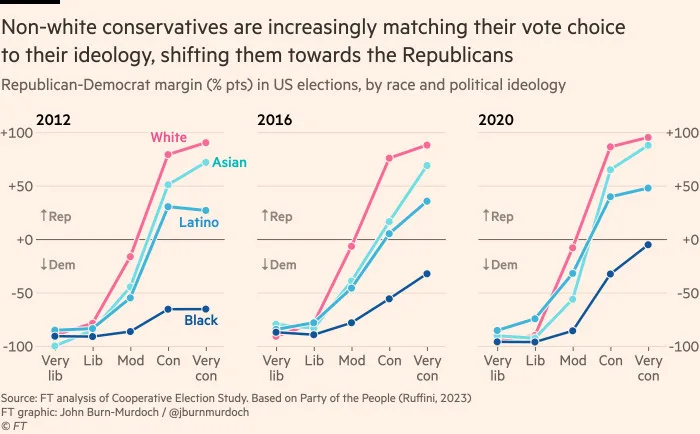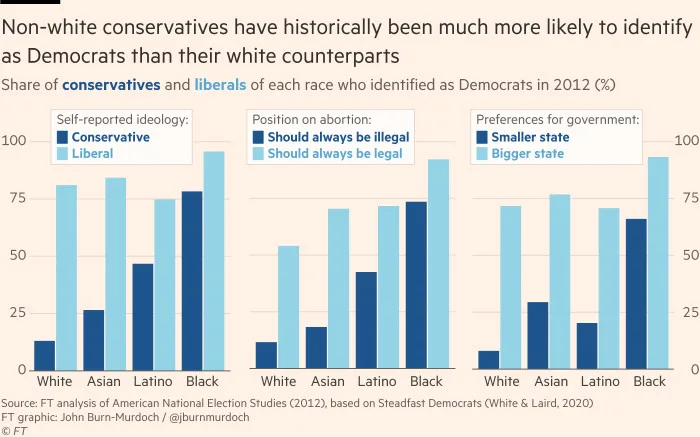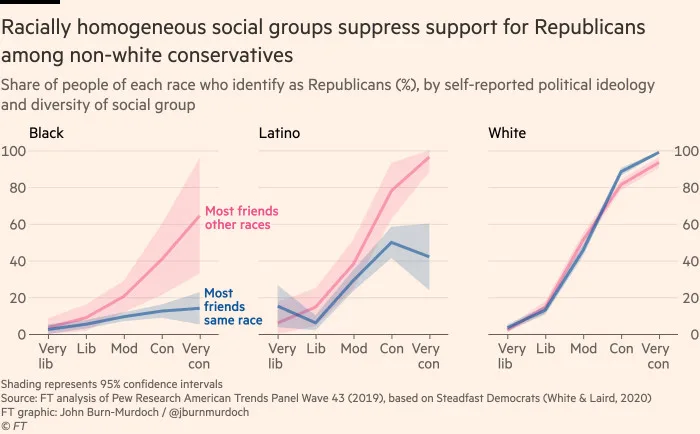Unlock the Editor’s Digest for free
Roula Khalaf, Editor of the FT, selects her favourite stories in this weekly newsletter.
Last week, a New York Times poll showed President Joe Biden leading Donald Trump by just 56 points to 44 among non-white Americans, a group he won by almost 50 points when the two men last fought it out for the White House in 2020. As things stand, the Democrats are going backwards faster with voters of colour than any other demographic.
Such startling statistics often meet accusations of polling error, but this cannot be written off as a rogue result. Data from America’s gold-standard national election surveys show Democrats’ advantage among Black, Latino and Asian voters at its lowest since 1960. Figures from Gallup show the same steepening decline.

Part of this is due to fading memories and weakening ties. Black Americans who lived through the civil rights era still support the party at very high levels, but younger generations are wavering. There’s also the weakening correlation between income and voter choice in US politics. The image of the GOP as the party of wealthy country club elites is dimming, opening the door to working- and middle-class voters of all ethnicities.
More ominous for the Democrats is a less widely understood dynamic: many of America’s non-white voters have long held much more conservative views than their voting patterns would suggest. The migration we’re seeing today is not so much natural Democrats becoming disillusioned but natural Republicans realising they’ve been voting for the wrong party.




This is best illustrated by US political researchers Ismail K White and Chryl N Laird, whose eye-opening 2020 book Steadfast Democrats demonstrates the incongruity between many black Americans’ policy preferences and votes.
Take deeply conservative positions such as support for gun rights or the belief that government should stay out of people’s lives and let them succeed or fail on their own. Very few white voters who take these positions identify as Democrats, but much larger shares of Black, Latino and Asian conservatives do.




History, culture and community have long overridden this misalignment between non-white conservatives’ policy positions and party choice. As recently as 2012, three in four Black self-identified conservatives were Democrats, but that has fallen to less than half. These voters won’t be won back by a bold environmental policy or defunding the police. Their historical support for Democrats was an anomaly and a further rightward shift is likely as it corrects.
White and Laird’s insight is that social networks play an important role. Among Black conservatives whose social circles are predominantly Black, support for Republicans remains anaemic, but among those whose friends, family or colleagues are more diverse, social norms are much weaker and support for the GOP rises. My extension of their analysis shows the same is true for other non-white groups.




There are echoes of voters in Britain’s Red Wall — the communities in northern England identified by pollster James Kanagasooriam with conservative demographics and attitudes that had stopped short of voting Tory due to a long-held sense that the party was not for them. In 2019 that changed.
Non-white Americans are in a similar position. Strong community norms have kept them in the blue column, but those forces are weakening. The surprise is not so much that these voters are now shifting their support to align with their preferences, but that it took so long.
As the US becomes less racially segregated, the frictions preventing non-white conservatives from voting Republican diminish. And this is a self-perpetuating process: discovering Republicans among one’s own group further weakens the stigma. As Republican pollster Patrick Ruffini puts it in his 2023 book Party of the People, this can create a “preference cascade”. Viewed in this light, the size of the shifts in current polling are entirely plausible.
To be clear, nothing in politics is guaranteed. Some shifts are temporary, and many of those deserting the Democrats will become swing voters rather than solid Republicans. They can be won back.
But the left’s challenge with non-white voters is much deeper than it first appears. A less racially divided America is an America where people vote more based on their beliefs than their identity. This is bad news for Democrats.

